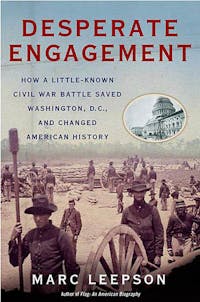Desperate Engagement
How a Little-Known Civil War Battle Saved Washington, D.C., and Changed American History
 Download image
Download image
ISBN10: 0312382235
ISBN13: 9780312382230
Trade Paperback
320 Pages
$23.99
CA$26.99
The Battle of Monocacy, which took place on the blisteringly hot day of July 9, 1864, is one of the Civil War's most significant yet little-known battles. What played out that day in the corn and wheat fields four miles south of Frederick, Maryland., was a full-field engagement between some 12,000 battle-hardened Confederate troops led by the controversial Jubal Anderson Early, and some 5,800 Union troops, many of them untested in battle, under the mercurial Lew Wallace, the future author of Ben-Hur. When the fighting ended, some 1,300 Union troops were dead, wounded or missing or had been taken prisoner, and Early—who suffered some 800 casualties—had routed Wallace in the northernmost Confederate victory of the war.
Two days later, on another brutally hot afternoon, Monday, July 11, 1864, the foul-mouthed, hard-drinking Early sat astride his horse outside the gates of Fort Stevens in the upper northwestern fringe of Washington, D.C. He was about to make one of the war's most fateful, portentous decisions: whether or not to order his men to invade the nation's capital.
Early had been on the march since June 13, when Robert E. Lee ordered him to take an entire corps of men from their Richmond-area encampment and wreak havoc on Yankee troops in the Shenandoah Valley, then to move north and invade Maryland. If Early found the conditions right, Lee said, he was to take the war for the first time into President Lincoln's front yard. Also on Lee's agenda: forcing the Yankees to release a good number of troops from the stranglehold that Gen. U.S. Grant had built around Richmond.
Once manned by tens of thousands of experienced troops, Washington's ring of forts and fortifications that day were in the hands of a ragtag collection of walking wounded Union soldiers, the Veteran Reserve Corps, along with what were known as hundred days' men—raw recruits who had joined the Union Army to serve as temporary, rear-echelon troops. It was with great shock, then, that the city received news of the impending rebel attack. With near panic filling the streets, Union leaders scrambled to coordinate a force of volunteers.
But Early did not pull the trigger. Because his men were exhausted from the fight at Monocacy and the ensuing march, Early paused before attacking the feebly manned Fort Stevens, giving Grant just enough time to bring thousands of veteran troops up from Richmond. The men arrived at the eleventh hour, just as Early was contemplating whether or not to move into Washington. No invasion was launched, but Early did engage Union forces outside Fort Stevens. During the fighting, President Lincoln paid a visit to the fort, becoming the only sitting president in American history to come under fire in a military engagement.
Historian Marc Leepson shows that had Early arrived in Washington one day earlier, the ensuing havoc easily could have brought about a different conclusion to the war. Leepson uses a vast amount of primary material, including memoirs, official records, newspaper accounts, diary entries and eyewitness reports in a reader-friendly and engaging description of the events surrounding what became known as "the Battle That Saved Washington."
Reviews
Praise for Desperate Engagement
"How small can a Civil War battle be and still claim the mantle of war-changing decisiveness? That proposition is tested in this engaging account of the 1864 Battle of Monocacy Junction, in which some 16,000 Confederate troops trounced 5,800 bluecoats on a Maryland field. Not a surprising outcome, but Leepson contends that Union Gen. Lew Wallace's doomed stand held up Confederate Gen. Jubal Early's surprise lunge at Washington, D.C.—which was held only by a hapless force of invalids, militia and government clerks—by one crucial day. The result was a photo finish, with Union reinforcements arriving in the nick of time to save the capital from capture (hence the decisiveness). Leepson lucidly narrates the campaign, adding color commentary about Early's 'panoply of abhorrent personal traits' and the incompetence, apathy and possible drunkenness that prevailed among Union commanders, along with plenty of vignettes of the horror and pathos of war. He also debunks the campaign's premier anecdote, which has Lincoln coming under rebel fire while looking out from Washington's ramparts (true, he finds) and getting chewed out—'Get down, you fool'—by a young Capt. Oliver Wendell Holmes Jr. (false) . . . a hard-fought, dramatic episode that Leepson brings vividly to life."—Publishers Weekly



